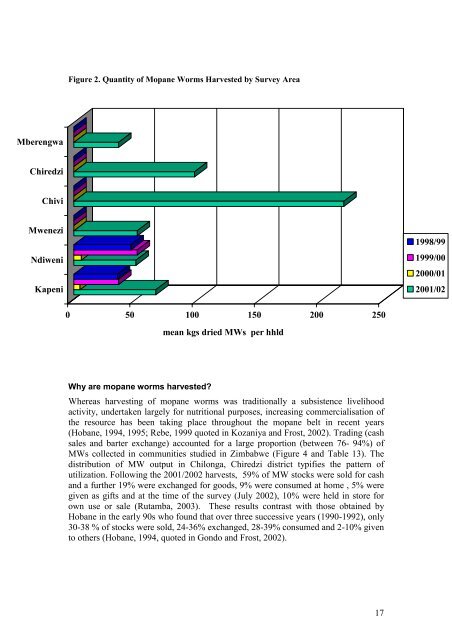Mopane worm utilisation and rural livelihoods in Southern Africa
Mopane worm utilisation and rural livelihoods in Southern Africa
Mopane worm utilisation and rural livelihoods in Southern Africa
Create successful ePaper yourself
Turn your PDF publications into a flip-book with our unique Google optimized e-Paper software.
Mberengwa<br />
Chiredzi<br />
Chivi<br />
Mwenezi<br />
Ndiweni<br />
Kapeni<br />
Figure 2. Quantity of <strong>Mopane</strong> Worms Harvested by Survey Area<br />
0 50 100 150 200 250<br />
Why are mopane <strong>worm</strong>s harvested?<br />
mean kgs dried MWs per hhld<br />
Whereas harvest<strong>in</strong>g of mopane <strong>worm</strong>s was traditionally a subsistence livelihood<br />
activity, undertaken largely for nutritional purposes, <strong>in</strong>creas<strong>in</strong>g commercialisation of<br />
the resource has been tak<strong>in</strong>g place throughout the mopane belt <strong>in</strong> recent years<br />
(Hobane, 1994, 1995; Rebe, 1999 quoted <strong>in</strong> Kozaniya <strong>and</strong> Frost, 2002). Trad<strong>in</strong>g (cash<br />
sales <strong>and</strong> barter exchange) accounted for a large proportion (between 76- 94%) of<br />
MWs collected <strong>in</strong> communities studied <strong>in</strong> Zimbabwe (Figure 4 <strong>and</strong> Table 13). The<br />
distribution of MW output <strong>in</strong> Chilonga, Chiredzi district typifies the pattern of<br />
utilization. Follow<strong>in</strong>g the 2001/2002 harvests, 59% of MW stocks were sold for cash<br />
<strong>and</strong> a further 19% were exchanged for goods, 9% were consumed at home , 5% were<br />
given as gifts <strong>and</strong> at the time of the survey (July 2002), 10% were held <strong>in</strong> store for<br />
own use or sale (Rutamba, 2003). These results contrast with those obta<strong>in</strong>ed by<br />
Hobane <strong>in</strong> the early 90s who found that over three successive years (1990-1992), only<br />
30-38 % of stocks were sold, 24-36% exchanged, 28-39% consumed <strong>and</strong> 2-10% given<br />
to others (Hobane, 1994, quoted <strong>in</strong> Gondo <strong>and</strong> Frost, 2002).<br />
17<br />
1998/99<br />
1999/00<br />
2000/01<br />
2001/02

















